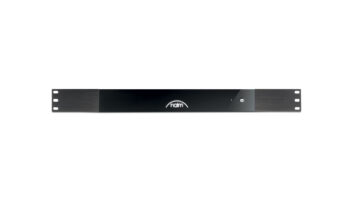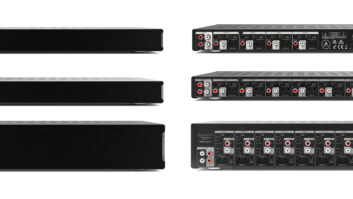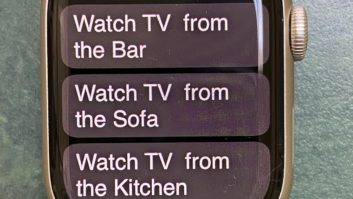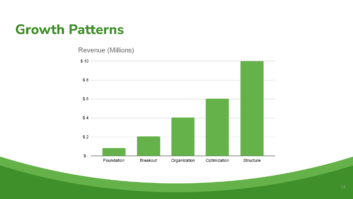
Three models of the Apple Watch share identical innards but differ in case material, with prices ranging from $349 to more than $10,000.
Given the heavy veil of secrecy that Apple very successfully imposes prior to new product announcements, it is normal for the rumor mills and blogs to speculate about what will be introduced. For the event held in San Francisco on March 9, there was no question that the Apple Watch would be central. Beyond that, the details of the watch and anything else was something that one could only guess about.
With regard to the Apple Watch, itself, I will simply summarize the top-level details you’ve most likely gotten from the popular and enthusiast press: Three models sharing the identical innards but differing in case material with prices ranging from $349 to more than $10,000. Pre-orders start on April 10, for availability starting on April 24. Battery life is quoted as “all day,” as long the day in which you will be awake and using it won’t be more than 18 hours.
So far, so good, and with the caveat again that I’ll let others describe more about the Watch elsewhere, my focus here is other announcements from the company. And, as is our want here, we’ll pay particular attention to the things that some might call minor or not even report on that have important significance for the custom installation world.
AppleTV Addition
Keeping everyone in suspense about the Apple Watch, the first part of the event dealt with an update to AppleTV. For those, including myself, who predicted a new AppleTV unit that might be 4K capable and add “hub” capability for home automation products, you’ve got a losing ticket. There was no new device but there was one interesting announcement: next month you will be able to subscribe to HBO NOW for a $14.99 monthly charge and watch any and all HBO programming via your AppleTV. Not to be confused with “HBO-GO” which is a TV Everywhere style service requiring a cable or satellite subscription, HBO NOW is service-provider independent and requires only a broadband connection.

Next month, AppleTV owners will be able to subscribe to HBO NOW for a $14.99 monthly charge and watch any and all HBO programming.
To those looking to “cut the cord” this is another part of the disintermediation of video content delivery away from the traditional providers and cable or satellite set tops. However, we’d be remiss in not reminding you that this now requires an AppleTV, if one is not already in place, the additional HDMI input to the display, AVR or surround processor, and sufficient broadband service to feed the hungry beast.
For those who view “OTT” as a means of getting things for free, that isn’t happening outside of over-the-air TV. It may, however, lower a client’s overall cost for content in some situations. It’s also worth noting that the price of the AppleTV device is now reduced to $69. Referring to the HBO deal, Tim Cook said that, “This is only the beginning.” We don’t doubt that, but it appears that we may have to wait a bit to see what comes next.
CarPlay
Those expecting new iPhones or iPads were left disappointed, though few really expected an off-cycle introduction in either of those areas. That is usually something for September or October. However, of interest to our market was the mention that, “Every major car brand is supporting CarPlay.” While few of us dabble in the world of “12-volt” installation, this does signal that the connected car is here to stay. To support upgrades and such as needed and to allow for easier configuration, do you make certain that a home network’s WiFi reaches to the garage or car port? That’s something that should now be a mainstay of your pre-bid questionnaires.
HomeKit
On the HomeKit front there was a similar comment, though to my mind it was a bit squishier. “HomeKit will change the way we control devices,” Cook said, but other than a promise of “more devices this year,” little was said about what they will be, who will offer them, and how they will integrate in the greater world of home automation. For now, that leaves the work up to the CI designer with perhaps the warning that we should watch carefully as to where Apple (and its competitors) take things in the months ahead. That “Home Hub” may yet appear and if/when it does, we’ll have to deal with it.
HealthKit
On the “HealthKit” front, the custom integration opportunity had more to do with the need for creating a more robust and reliable home network infrastructure for something called “ResearchKit.” Unlike the claimed 900-plus health and fitness apps for iOS, ResearchKit will help medical researchers gather data from larger subject universes to build more accurate data from which to do their work and testing. In some cases, the university-driven projects include testing for the progress of Parkinson’s patients in a way that might assist their treatment by providing regular activities and the prompts to do them.
Yes, some of these will deliver direct feedback to the patient/research subject, but it would appear that the devices used in these testing regimes and projects are not something that a non-medical company would provide. Here, too, time will tell, but other than the availability of ResearchKit as open-source, there appears to be little business-actionable opportunity at this time.
The one other new product introduction that should interest the CI community is the new MacBook. Lighter and thinner, though less powerful than a MacBook Air, the new models (some basic platform with a 12-inch Retina display with a choice of two processor/drive capacity configurations and three colors), one could immediately hear Mac-heads all over saying, “I WANT ONE”.
Clearly an object of desire for some, it may bring business opportunities and configuration problems to others. The slim size and light weight are due to many design and technology advancements, but the one that impacts us is that all current-generation connections, and we mean ALL of them (DisplayPort, Thunderbolt, USB, HDMI, MagSafe charging port, etc.) with the sole exception of an analog/digital audio output are GONE. Replacing them is a single USB-C connector that, with the appropriate cables or dongles is used to connect to displays, hard-wired networks or to myriad USB-connected portable drives, backups, thumb drives, and everything else. Oh, and while the battery life is greatly extended, if you use the USB-C for connection to anything other than the power brick, you’ll want to make certain there is a pass-through to connect to AC power.
There’s nothing wrong with that, but take a step back and consider what it means for one of these as you or a client might use it. Where security or other concerns dictate a hard-wired, rather than wireless, connection you’ll need to replace something. Same for copying files to a USB stick to blow new software into client devices or systems. Is a display in the mix to stream content from the new MacBook? Either provision for wireless or yet ANOTHER dongle, and power pass-through is required. New, thin, and light is great, but be certain you know how a seemingly simple change of connector types can foul up existing systems and place different requirements on new ones.

Existing DisplayPort connects can be made with adapters to USB-C, as shown here in an CES demo.
With the preliminaries over, just as was the case at the Apple event, we need to get to the main focus, the Apple Watch. Beyond what you’ll read elsewhere, there are some things you’ll need to be aware of that the mainstream press might miss. First, as your clients purchase the Watch, remember that it will require a concurrent upgrade to the new iOS 8.2 on their iPhones. Next, you’ll need to remember that the Watch needs to “see” the iPhone to do most, if not all, of its important tasks. Yes, that can be done by WiFi, but only to the WiFi in the phone, not in the home network at large. (At least as of this time.) If a client thinks they can leave their phone on a room that is out of WiFi range of the Watch they will find that functions may not work. It may seem obvious, but prevent service calls by reminding them of that.
Next, remember that this is a product that will have to be recharged every day (or, more likely, every night). The magnetic charging cable has a USB on the other end, so you’ll need to make certain that there are sufficient outlets or USB power ports available at likely places such as bedside furniture. Given the high-profile customer base for some of the models, the idea of an outlet strip to power the charger may not be that attractive.
Don’t get the idea that I’m down on the Apple Watch. The possibility to integrate monitoring, control, and automation devices with something in a small form factor, is appealing in the macro sense. For some, the Apple Watch will be a status symbol that they really won’t use to its full potential. Yet, particularly when the owner is a celebrity it will give the concept and extended home control/automation apps exposure that will help grow the market. Think of the exposure for the benefits of electric vehicles that Tesla has brought to the market even though anyone who can afford one now probably isn’t buying a Tesla because they worry about the price of gas.
Similarly, the Apple Watch is sure to step up the responses from competitors such as Samsung, LG, Motorola, Pebble, and others. Like the idea of an Apple Watch but are facing clients who want to keep their Android phones? They are and will be out there. Let the concept, applications, and integration possibilities drive how you react to the Apple Watch for your specific business and client base.
CEDIA Fellow Michael Heiss is a contributing editor to Residential Systemsout of Sherman Oaks, CA.








